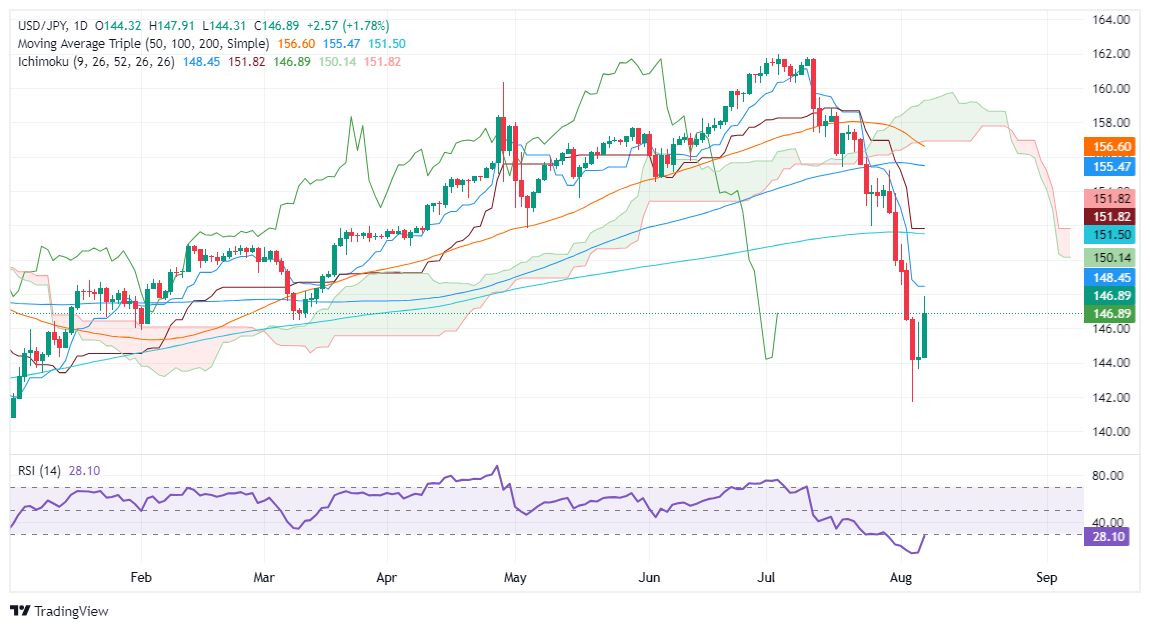- Analytics
- News and Tools
- Market News
- USD/JPY Price Forecast: Soars over 1.50% on BoJ dovish stance
USD/JPY Price Forecast: Soars over 1.50% on BoJ dovish stance
- USD/JPY surges 240+ pips, trading at 146.86, fueled by BoJ comments.
- Breaking 148.00 may target Tenkan-Sen at 148.45, then 149.00.
- Failure to hold 146.37 could lead to pullback to 146.00 and 145.00.
The USD/JPY soared late in the North American session, up by more than 1.50% or 240 plus pips, after a Bank of Japan official stated that they would not raise rates in an unstable market environment. Therefore, the pair rallied from daily lows of 144.28 and traded at 146.86 at the time of writing.
USD/JPY Price Forecast: Technical outlook
Although Tuesday’s rebound was short-lived, comments by BoJ officials spurred a U-turn on the USD/JPY, which posted a close below 144.20 on Tuesday, but it’s registering its largest gains since March 2023.
If USD/JPY extends its gains past the 148.00 figure, this could exacerbate a test of the Tenkan-Sen at 148.45. Further gains lie overhead at 149.00 before buyers can push the exchange rate toward the 200-day moving average (DMA) at 151.50.
Conversely, if sellers push the exchange rate below the August 6 high of 146.37, that will pave the way for a pullback. The next support will be the 146.00 mark, followed by the 145.00 figure. Further losses lie underneath at the August 6 low of 143.61.
USD/JPY Price Action – Daily Chart
Japanese Yen FAQs
The Japanese Yen (JPY) is one of the world’s most traded currencies. Its value is broadly determined by the performance of the Japanese economy, but more specifically by the Bank of Japan’s policy, the differential between Japanese and US bond yields, or risk sentiment among traders, among other factors.
One of the Bank of Japan’s mandates is currency control, so its moves are key for the Yen. The BoJ has directly intervened in currency markets sometimes, generally to lower the value of the Yen, although it refrains from doing it often due to political concerns of its main trading partners. The current BoJ ultra-loose monetary policy, based on massive stimulus to the economy, has caused the Yen to depreciate against its main currency peers. This process has exacerbated more recently due to an increasing policy divergence between the Bank of Japan and other main central banks, which have opted to increase interest rates sharply to fight decades-high levels of inflation.
The BoJ’s stance of sticking to ultra-loose monetary policy has led to a widening policy divergence with other central banks, particularly with the US Federal Reserve. This supports a widening of the differential between the 10-year US and Japanese bonds, which favors the US Dollar against the Japanese Yen.
The Japanese Yen is often seen as a safe-haven investment. This means that in times of market stress, investors are more likely to put their money in the Japanese currency due to its supposed reliability and stability. Turbulent times are likely to strengthen the Yen’s value against other currencies seen as more risky to invest in.
© 2000-2025. All rights reserved.
This site is managed by Teletrade D.J. LLC 2351 LLC 2022 (Euro House, Richmond Hill Road, Kingstown, VC0100, St. Vincent and the Grenadines).
The information on this website is for informational purposes only and does not constitute any investment advice.
The company does not serve or provide services to customers who are residents of the US, Canada, Iran, The Democratic People's Republic of Korea, Yemen and FATF blacklisted countries.
Making transactions on financial markets with marginal financial instruments opens up wide possibilities and allows investors who are willing to take risks to earn high profits, carrying a potentially high risk of losses at the same time. Therefore you should responsibly approach the issue of choosing the appropriate investment strategy, taking the available resources into account, before starting trading.
Use of the information: full or partial use of materials from this website must always be referenced to TeleTrade as the source of information. Use of the materials on the Internet must be accompanied by a hyperlink to teletrade.org. Automatic import of materials and information from this website is prohibited.
Please contact our PR department if you have any questions or need assistance at pr@teletrade.global.
















